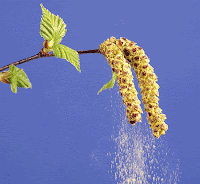The weather may be misbehaving, but the Hay Fever season is looming. So what better time to pass on some of my tried and tested natural Hay Fever home remedies?
Image via The Telegraph
So What is Hay Fever, What Causes It and What Are the Symptoms?
Hay Fever (allergic rhinitis), is an allergic response to airborne substances such as pollen and the time of year you get it is dependent upon which of these substances you are allergic to.
Hay Fever happens when your immune system thinks a harmless airborne substance is a threat and produces the antibody 'immunoglobulin E' to beat the living daylights out of it! Your body release a chemical called 'histamine' which causes your symptoms.
Image via Pollen Allergies Symptoms
Some causes are:
Tree pollen - tends to affect people in the spring.
Grass pollen - tends to affect people later on in the spring and in the summer.
Weed pollen - tends to affect people common in the autumn.
Fungi and mould spores - more common when the weather is warm.
The common symptoms are: sneezing, watery eyes, itchy throat, itchy nose and blocked/runny nose.
The more extreme symptoms are: sweats, headaches, loss of smell and taste, facial pain caused by blocked sinuses or itchiness spreading from the throat, to the nose and ears.
Taking a tip of a teaspoons worth of local honey daily, really has worked wonders for my Hay Fever. This was recommend by our family Acupuncturist. I take it all year round. I buy the smallest pot I can get so the honey contains pollen from this season.
My delicious local honey. Image via Pride Of Northumbria
By 'Local' honey I mean honey made by bees kept near to where you live or work. The reason being you may be allergic to specific pollen, from plants growing in your area. If the honey contains minute quantities of that pollen, then eating the honey little and often may help to desensitise you.
Soothe Your Sore Eyes
I like to keep my Eve Taylor Eye Gel in the fridge and pop around my eyes. It contains Aloe Vera and Seaweed to soothe and cool my sore and itchy eyes.
Milk Eye Pads are fantastic for sore eyes, just pop some on a cotton pad lay them on your eyes and relax. Milk has antibacterial and other amazing healing powers. Obviously not one to go for if you are allergic to dairy!
Image via Science Daily
Cool Chamomile Tea bags are great for the eyes as Chamomile is anti inflammatory and soothing. Make a cup of tea, pop the tea bags in the fridge until cool and pop on your eyes for a nice relaxing treatment. Drinking the tea will help the body calm from the inside. Great for kids too.
Image via Fashion Addict
Drink Nettle Tea
Nettles contain chemicals with antihistamine and has anti-inflammatory properties, these are thought to help suppress the allergic response of Hay Fever. I like to mix mine with Chamomile Tea and honey to get a triple whammy!
Nettle Tea - image via Natural Health and Home Business
This balm helps reduce the allergens from entering the body. The Chamomile is anti inflammatory and soothing.
1. Take a little pot and add 2 tsp of Non Petroleum Jelly (see recipe below) and 4 drops of Roman Chamomile and mix thoroughly with something thin like a cocktail stock.
2. Pop a small amount in the lining and base of your nose.
3. Re-apply regularly and after sneezing or blowing nose.
Why Make Non Petroleum Jelly?
For those of you who have read my Are You Using the Right Lip Balm? article, you will know why I don't rate using Vaseline and other Petroleum Jellies and prefer Beeswax.
Here is a quick recap:
Mineral oil or Paraffin (cheap by-products of petroleum) draws moisture away from the lips and skin. It is known to clog pores and block the skin’s ability to moisturise itself. So here is my recipe to make a safer and more effective version.
Image via From Nature With Love
Non Petroleum Jelly Recipe (makes approx 200ml)
You can then use this as a base for other products such as lip balm, antiseptic balm, vapour rub, muscle rub. I'll be adding recipes for these over time, so keep your eyes peeled!
You will need
1¼ oz. beeswax pellets
3/4 cup (175ml) sweet almond oil (or organic coconut or olive oil)
1. Put the ingredients in a heat proof bowl on top if a pan of simmering water (just like when melting chocolate). Ensuring the water doesn't touch the bowl.
2. Melt ingredients together.
3. Remove from heat and pour into a suitable container. I like to put mine in recycled sterilised beauty potion pots. I keep all my beauty potion glass jars and lip balm jars and sterilise them in the dishwasher.
(You can buy the beeswax pellets and the oils from Phyto Essential Oils)
Image via A Delightful Home
Thickness of Your Jelly
For a softer consistency use 1 oz. of beeswax.
For a firmer consistency use 1½ oz. of beeswax
For a very soft consistency - like an ointment use ½ oz of beeswax
I would love to know how these remedies work for you and any of your own.









Very true. Making it a habit or ritual gives extra health to our body.
ReplyDeleteSara have you thought of making and selling some of these remedies and others you include elsewhere on the Blog?!
ReplyDeleteWould love to but it's a whole new qualification, legislation and rules to sell products to the public. Thanks for the confidence vote though!
Delete